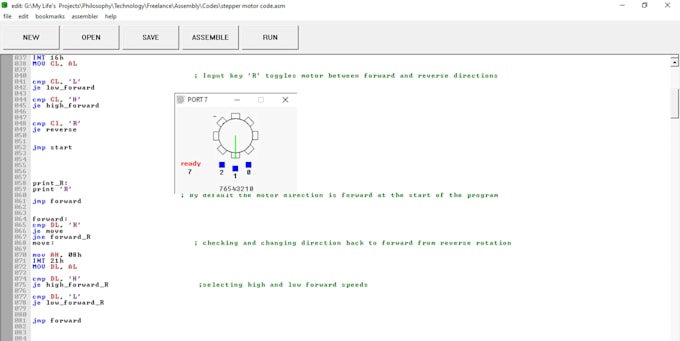
So mov dword, 123 will disastrously assemble as mov 4, 123 which is the same as. In MASM, dword by itself (not dword ptr) evaluates as the number 4, because that's the width of a dword.
#EMU8086 VS MASM CODE#
Other random things when assembling code with the wrong assembler:
#EMU8086 VS MASM MANUALS#
The x86 tag wiki has links to assembler manuals and much more. MASM and NASM have significant macro capabilities, but they use different syntax. It also has %rep directives to repeat a block. You can use it on anything, even instructions. NASM has times 30 db 0x10 to repeat the byte 0x10 30 times. Instead, they have count DUP(value), where value can be ?.

MASM/TASM doesn't have resb / resd directives. %define means NASM, while MACRO means MASM/TASM.
#EMU8086 VS MASM FULL#
( Good catch, If the source is full of macros, then look for the defs.

%define result eax would allow mov result, 5. Unless the symbol is actually a macro definition for a register, e.g. mov foo, eax), it's definitely not NASM, because mov imm32, r32 makes no sense. if you ever see a bare symbol as the destination operand (e.g. I assume MASM/TASM allows you to write dd 0 in the BSS, but I'm not sure)Ĭounter: dd 0 reserve space for one dword (zeroed)īuf db 256 dup(?) reserve 256 bytes (uninitialized).Įxcept where I commented otherwise, any of these differences are a guaranteed sign that it's NASM/YASM or MASM/TASM/emu8086Į.g. (In most OSes, the BSS is initialized to zero. With a : after the name, it would be just a label, not a "variable" with a size associated. Mov esi, OFFSET static_var mov esi,imm32 with the address. Mov eax, static_array is also allowed, but not required. Mov eax, static_var mov eax, is the same, and recommended by some for clarity db 12h.CODEįoo PROC PROC/ENDP definitely means not NASMĪdd counter, 1 operand-size magically implied by the dd after the counter label. And GAS directives / pseudo-instruction are totally different, like.

intel_syntax noprefix is mostly the same, but without the magic operand-size association for labels. MASM/TASM (I may have some of this wrong, I don't use MASM or TASM): But loop resd 1 won't because loop is a valid instruction mnemonic. This is recommended but not required: any unknown token at the start of a line is assumed to be a label so counter resd 1 will assemble. Note the : after label names here, even for data. MASM only allows 0DEADBEEFh styleĬounter: resd 1 reserve space for one dword (initialized to zero) Static_var: dd 0xdeadbeef NASM can use 0x. Mov esi, static_var mov esi,imm32 with the address of the static_var Mov eax, Everything *must* be inside the in segment overrides), but these should be enough to tell by looking whether something is NASM-style or MASM-style.Īdd dword, 1 Error without "dword", because neither operand implies an operand-size for the instruction. There are probably other differences in syntax, too (e.g. In NASM, you have to use to create a memory operand, and foo is the address. You have to use offset foo to get the address of foo. In MASM (and I think TASM/emu8086), a bare symbol name referes to the contents. In TASM/MASM style, you have to write dword ptr or byte ptr. In NASM, explicit sizes on things like memory operands use dword or byte.

#EMU8086 VS MASM HOW TO#
I don't know how to distinguish MASM from TASM, or TASM from emu8086, or FASM, so I'll leave that for another answer to address. YASM uses NASM syntax, with a few minor differences in what it accepts for constants and directives. NASM/YASM is easy to distinguish from MASM/TASM/emu8086.


 0 kommentar(er)
0 kommentar(er)
